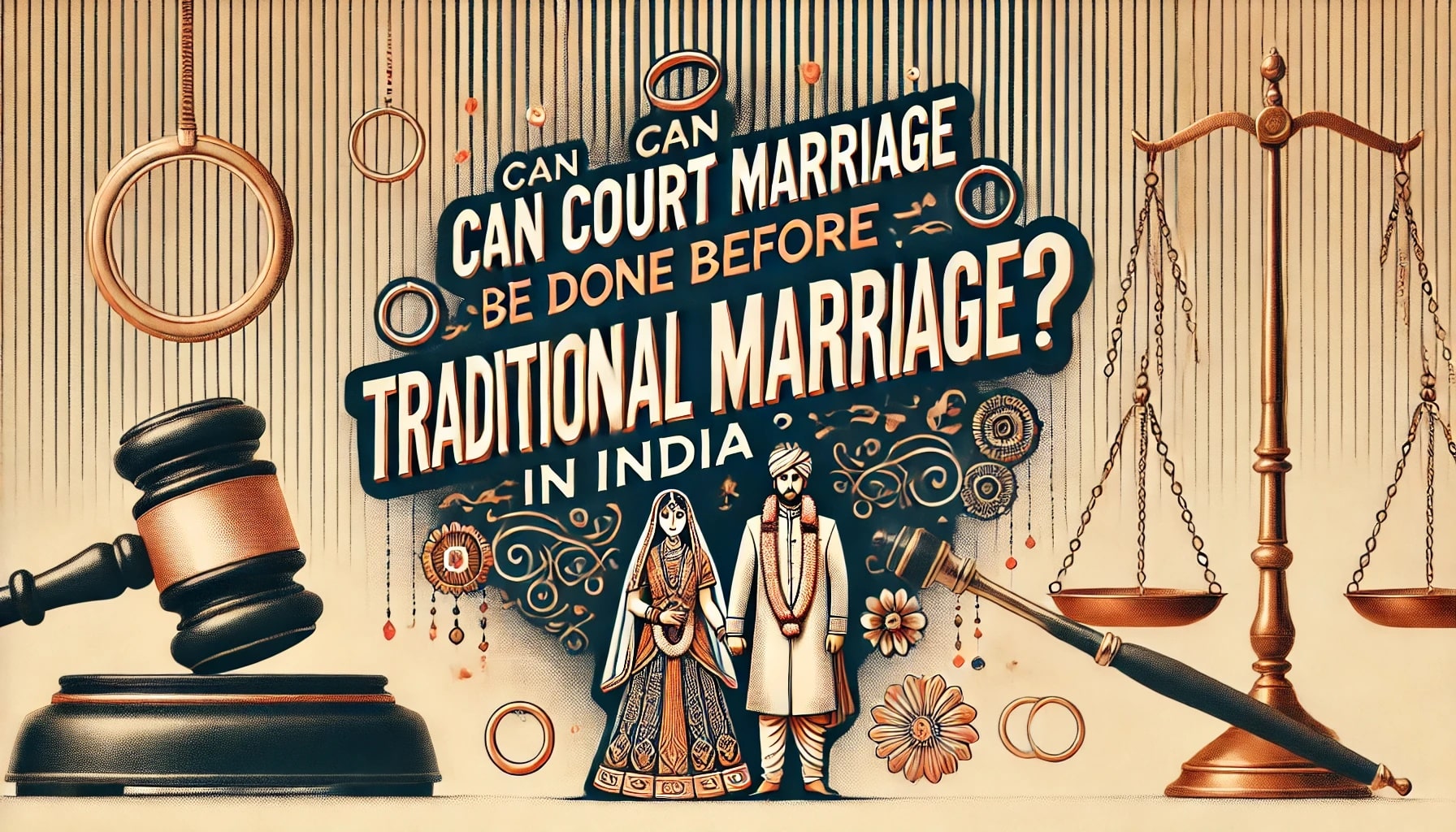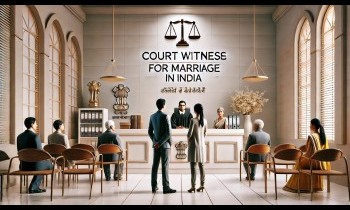Can Court Marriage be Done Before Traditional Marriage in India

Date : 19 Jan, 2025
Post By admin
In India, couples can choose court marriage before traditional ceremonies, ensuring legal recognition under the Special Marriage Act and respecting personal and cultural preferences. This approach allows them to navigate their marital journey with clarity and security, as they receive an official marriage certificate that serves purposes like immigration applications and property rights claims. By opting for court marriage first, individuals establish a solid legal foundation while addressing familial expectations and societal norms surrounding traditional practices.
Overview of Court and Traditional Marriage Laws.
In India, the legal field surrounding marriage is shaped by court marriages and traditional ceremonies, each governed by distinct laws.
1. Court Marriages: Under the Special Marriage Act of 1954, individuals can marry regardless of their religious backgrounds. This process includes:
- Filing a notice with the local registrar to announce intent.
- A mandatory waiting period of 30 days during which objections may be raised.
- The presence of at least two witnesses during registration.
2. Traditional Marriages: These follow cultural or religious customs specific to communities—Hindu, Muslim, or Christian rites—and incorporate rituals that signify union according to personal laws.
Both forms hold equal legal weight in India; couples must ensure their choices align with personal beliefs and familial expectations while navigating these options thoughtfully.
Couples are encouraged to consider court marriage before any traditional festivities. This decision impacts various facets:
- Legal Standing: A couple who marries under the Special Marriage Act enjoys immediate recognition as legally married partners, regardless of subsequent ceremonial practices.
Documentation Benefits: Upon completion of court marriage registration, couples receive an official certificate serving as evidence for their marital status—a critical document for immigration processes.
3. Social Dynamics play a vital role in this decision-making journey:
- While permissible within Indian law, societal acceptance may fluctuate based on cultural norms; some families may prioritize traditional rituals over formal registrations due to perceived significance.
Lawtendo serves as a resource in guiding individuals through these processes—offering insights into matrimonial law and immigration implications—to empower informed decisions aligned with their circumstances while respecting established traditions.
Marrying via courts before pursuing customary celebrations is supported within India’s diverse matrimonial ecosystem when approached judiciously. Careful navigation around social sentiments and thorough documentation preparation regarding visa applications will aid in ensuring smooth transitions into married life without complications arising from misunderstandings about legitimacy stemming from different wedding formats.
Steps Involved in Court Marriage Registration.
1. The process of registering a court marriage in India involves essential steps that ensure legal compliance and clarity for the couple. The couple must file a notice of intended marriage with their local registrar. This notification serves as an announcement of their intent to marry and is crucial for initiating the registration process.
2. After submission, a waiting period of 30 days begins during which any objections to the marriage can be raised. This time frame allows for transparency regarding marital intentions—an important aspect in Indian society where familial involvement often plays a significant role.
3. To finalize their marriage registration, at least two witnesses must be present when they meet with the registrar, affirming their consent and confirming that all legal requirements have been met prior to official recognition as married partners.
4. Lawtendo provides valuable assistance by offering expert guidance tailored to individual circumstances surrounding court marriages in India. Their resources include insights into documentation needs and help facilitate communication between couples and registrars throughout this procedure.
5. Once registered, couples receive an official marriage certificate—a vital document signifying marital status and beneficial for situations like visa applications or property ownership rights later in life.
6. It is advisable for individuals embarking on this journey to maintain thorough records from each step taken during registration; doing so ensures accuracy when addressing potential future inquiries related to legality stemming from matrimonial commitments established through courts versus traditional ceremonies.
Key Elements of Traditional Marriage Ceremonies.
Traditional marriage ceremonies in India are rich with cultural and religious significance, reflecting the diverse customs of various communities. Key components typically include:
1. Rituals: Each community has unique rituals that symbolize union and commitment. Hindu weddings feature the 'Saptapadi,' where couples take seven steps together, representing their vows to support one another.
2. Festivities: Weddings often encompass vibrant celebrations filled with music, dance, and feasting, designed to honor familial ties and foster joy among participants.
Family involvement is crucial in traditional marriages. Families actively participate in pre-wedding festivities like engagement parties or mehendi ceremonies before the main event:
1. Consent & Blessings: Family members provide blessings, underscoring mutual respect between families; this is vital within collectivist cultures prevalent in India.
2. Community Support: The presence of extended family during these occasions reinforces social bonds and cultural continuity passed down through generations.
Lawtendo serves as a valuable resource for navigating both court and traditional marriages by offering expert guidance tailored to individual needs amidst complex legal frameworks governing matrimonial practices:
1. Consultation Services: Couples can access personalized advice on merging legal requirements associated with court registrations while maintaining family traditions.
2. Documentation Assistance: Lawtendo ensures proper documentation is maintained throughout all processes, helping individuals fulfill ceremonial expectations while adhering to legal obligations.
Legal Recognition of Court Marriages in India.
In India, court marriages are recognized under the Special Marriage Act of 1954, allowing couples from different religious backgrounds to unite without adhering strictly to traditional customs. The process begins with filing a notice of intended marriage at the local registrar's office, followed by a mandatory waiting period of 30 days for any objections. This step ensures transparency and community awareness regarding marital intentions. Successful registration requires at least two witnesses who affirm the couple’s consent on the day they meet with the registrar, leading to official recognition as legally married partners.
Couples receive a marriage certificate post-registration, essential for purposes like immigration or property rights.
Choosing to marry through courts before customary celebrations offers advantages but may present challenges related to societal acceptance. While both court and traditional marriages are equally valid under Indian law, families often prioritize traditional rituals over formal registrations due to perceived significance. Lawtendo serves as a valuable resource during this journey; it provides guidance on navigating legal stipulations and familial expectations effectively. By assisting couples with documentation preparation and offering tailored advice throughout their matrimonial processes, Lawtendo empowers individuals seeking clarity while honoring their diverse cultural values within India's complex social field.
Cultural Norms Affecting Court Marriage Perception.
In India, cultural norms significantly shape perceptions of court marriages, influencing couples' marital choices.
1. Family Expectations: Many families uphold traditional views that prioritize customary rituals over legal formalizations. This emphasis on tradition can lead to resistance when younger generations consider court marriage first. Some parents may perceive a lack of respect for ancestral practices if their children choose the legal route before religious ceremonies.
2. Social Acceptance: Acceptance of court marriages varies across communities and regions; urban areas may exhibit more progressive attitudes, while rural settings often adhere strictly to conventional customs. Couples must be sensitive to familial sentiments and societal expectations surrounding marriage traditions.
Lawtendo serves as a vital resource during this navigation process by offering support to bridge the gap between modern practices and established customs.
1. Consultation Services: Experts provide insights into balancing legal requirements with family traditions, helping couples articulate their decisions effectively without alienating loved ones.
2. Community Engagement: Lawtendo encourages open dialogue within families about personal preferences regarding matrimonial options, fostering understanding among diverse perspectives.
Individuals contemplating court marriage should prioritize legality while remaining attuned to the social dynamics at play, requiring empathy and informed decision-making throughout their journey toward matrimony.
Impact on Visa Processes Like K-1 and CR-1.
Navigating immigration processes like K-1 and CR-1 visas can influence a couple's decision to marry in court before traditional ceremonies. For couples applying for K-1 fiancé(e) visas, it is crucial to understand that any wedding before visa approval may complicate the application. U.S. Immigration authorities could see pre-wedding events as indicators of an established marriage, jeopardizing the validity of their K-1 application. Legal compliance with U.S. Requirements necessitates delaying ceremonial celebrations until after obtaining visa approval.
Those opting for CR-1 spousal visas might benefit from conducting traditional ceremonies before submitting their applications. This approach often alleviates complications by acknowledging both legal and cultural aspects of marriage—making documentation more straightforward during processing. Regardless of the chosen route, Lawtendo provides essential support throughout this journey by offering expert advice on ensuring all necessary paperwork is accurately prepared and organized—including documentation from court registrations and traditional celebrations—to facilitate smoother transitions into married life without facing obstacles due to misconceptions about marital legitimacy.
Required Papers for Immigration Applications.
Navigating immigration applications requires attention to detail, particularly regarding documentation. For individuals applying for a K-1 fiancé(e) visa, understanding the implications of their marital status before approval is crucial.
1. Marriage Certificate: Couples must present their official marriage certificate from court registration as proof of legal union—this document validates their relationship during the application process.
2. Supporting Evidence: Immigration authorities may request additional evidence like photographs from ceremonies or invitations; these help establish the authenticity of the couple's commitment.
In contrast, those applying for a CR-1 spousal visa should note that having traditional ceremonies before submitting applications can simplify matters.
1. Documentation Requirements: Couples should maintain thorough records throughout this journey—ensuring all necessary paperwork accurately reflects their matrimonial choices (court versus traditional).
2. Legal Compliance: This careful preparation aids in expediting processing times and minimizes potential misunderstandings regarding legitimacy stemming from different types of marriages.
Lawtendo assists couples with guidance tailored to fulfilling immigration requirements effectively while balancing personal traditions and legal stipulations. Their expertise ensures partners are well-prepared with organized documents ready for submission at every stage of their new chapter together.
Understanding Family Expectations in Marriage.
Navigating family expectations during marriage is a complex process rooted in cultural norms and traditions.
1. Cultural Significance: Many families prioritize traditional rituals, viewing them as essential for maintaining familial honor and community ties. This can create friction when younger generations consider court marriages first, which may be seen as a deviation from customs.
2. Parental Perspectives: Parents often hold strong beliefs about honoring ancestral practices; some may feel disrespected if their children choose legal formalizations over customary ceremonies without seeking family approval or blessings. The emotional weight of these traditions can lead to resistance against modern choices that challenge long-standing values.
Lawtendo offers guidance to help couples navigate these dynamics effectively.
1. Expert Consultation: Their team provides insights into balancing legal obligations with family expectations, ensuring decisions reflect individual desires and cultural sensitivities without alienating loved ones.
2. Open Dialogue Facilitation: Lawtendo encourages discussions within families regarding marital preferences, fostering understanding while respecting diverse perspectives on marriage options today.
Individuals are urged to approach this journey with empathy and openness towards familial sentiments while making informed decisions aligned with personal aspirations regarding matrimony.
Advice on Navigating Marriage Choices Effectively.
Couples navigating the decision between court and traditional marriage in India should prioritize open dialogue with family members while considering their beliefs. Engaging relatives early can help mitigate misunderstandings about each option, allowing for an empathetic discussion of expectations surrounding marital practices. This conversation aids couples in articulating their choices and respects familial sentiments that may influence acceptance. Consulting legal experts familiar with matrimonial laws and social customs can illuminate potential challenges, ensuring informed decisions regarding the timing and approach to either type of ceremony.
Thorough documentation is vital throughout this journey; maintaining clear records will assist during future processes like immigration applications or property rights claims. Couples should gather necessary paperwork—including marriage certificates from court registrations and evidence from traditional ceremonies—to validate their relationship when required by authorities. Lawtendo offers tailored support through every step—providing guidance on necessary documentation based on individual circumstances while facilitating communication between partners and registrars involved in these formalities. By preparing diligently and remaining sensitive to cultural norms, individuals can navigate their paths toward matrimony effectively while fostering understanding among loved ones.
Summary of Court Vs. Traditional Marriage Insights.
In India, couples can choose court marriage before traditional ceremonies, a decision with significant legal and social implications.
1. Legal Recognition: Marrying under the Special Marriage Act ensures immediate validity as legally recognized partners, providing personal clarity and societal acceptance.
2. Documentation Importance: Couples receive an official marriage certificate after registration—an essential document for immigration applications or property rights claims.
Navigating familial expectations is crucial when choosing between marital formats.
1. Cultural Norms: Many families prioritize traditional customs over formal registrations; younger generations may face resistance when opting for a court marriage first. Open discussions with family members can alleviate misunderstandings and foster respect regarding individual choices in matrimony.
2. Emotional Considerations: The weight of tradition may create friction but highlights the importance of engaging relatives during this process to bridge gaps between modern practices and established beliefs.
Immigration considerations complicate decisions surrounding marital format choice, particularly for those applying for K-1 or CR-1 visas in the U.S.:
1. For K-1 fiancé(e) visas, conducting wedding activities prior to visa approval could jeopardize application legitimacy; a strategic delay may be necessary until securing legal status.
2. Pursuing CR-1 spousal visas often encourages holding traditional ceremonies beforehand, simplifying documentation processes by acknowledging both cultural expressions and legal requirements.
Lawtendo provides tailored support to navigate complex matrimonial laws effectively:
1. Experts offer advice on balancing legal stipulations with family traditions without alienating loved ones.
2. Their assistance covers thorough documentation preparation, ensuring couples feel confident about fulfilling obligations amidst varying perceptions toward different types of marriages within Indian society today.
Understanding regional attitudes toward various forms helps couples make informed decisions aligned with personal desires while respecting ingrained cultural values—a delicate balance reflecting empathy and awareness throughout one’s path toward unity.
FAQ
What are the legal requirements for conducting a court marriage in India?
The legal requirements for conducting a court marriage in India include filing a Notice of Intended Marriage with the local registrar, observing a 30-day waiting period for objections, and having at least two witnesses present during registration.
How does a court marriage differ from a traditional marriage in terms of legal recognition?
A court marriage is legally recognized under the Special Marriage Act of 1954, allowing inter-religious unions without adherence to religious customs, while a traditional marriage is recognized based on the personal laws of communities and may involve cultural rituals.
Can couples legally marry through a court before having a traditional wedding ceremony?
Couples can marry through a court before having a wedding ceremony in India.
What are the immigration implications for couples considering K-1 or CR-1 visas after their marriage?
The immigration implications for couples considering K-1 visas involve avoiding wedding-like ceremonies before securing legal status in the U.S. To prevent complications. Those opting for CR-1 visas may benefit from conducting traditional ceremonies first, acknowledging both legal and cultural aspects of marriage.
How can cultural expectations influence the decision to choose court marriage over traditional marriage?
Cultural expectations lead individuals and couples to prioritize traditional marriage ceremonies over court marriages, as they seek to honor familial values and societal norms while navigating personal choices.
What steps should couples take to ensure proper documentation during their marriage proceedings?
Couples ensure proper documentation during marriage proceedings by maintaining records of all relevant paperwork, including marriage certificates, photographs from ceremonies, and invitations, while consulting legal experts for guidance.





